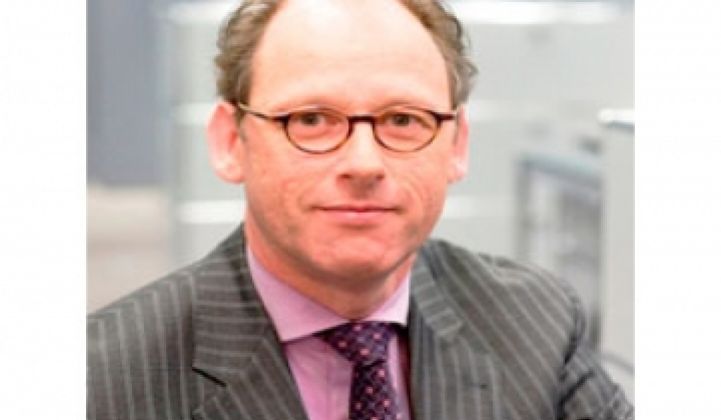The bright sun and cloudless sky of the American southwest has beckoned many solar-thermal power project developers. But so far, the idea of making the desert bloom with mirrors and other equipment to harness the sun's heat for power generation hasn't materialized.
Last year, no commercial solar thermal power plants came online in the United States, according to the Solar Energy Industries Association. Many companies interested in building solar-thermal power plants are largely in the development mode.
We caught up with Ruud Dekkers, head of project development at MAN Solar Millennium, not so long ago to get some perspectives on the players and market landscape in the solar-thermal power field. The German company, founded in 2007, is a joint venture of MAN Ferrostaal and Solar Millennium. The JV is drawing expertise from its parents companies for developing and building power plants with 20-megawatt to 250-megawatt in capacity.
MAN Ferrostaal is an established builder of petrochemical, oil, gas, biofuel and other industrial plants, and the International Petroleum Investment Co. of Abu Dhabi bought a 70 percent stake in the company earlier this year. Solar Millennium, which said it developed Europe's first solar thermal power plant using parabolic-trough technology (with energy storage), is a technology and power project developer who has been erecting solar-thermal power fields in Spain and Egypt.
The American subsidiaries of both companies are now developing a 250-megawatt power plant in the Amorgosa Desert in Nevada. The companies signed a memorandum of understanding with NV Energy to develop the project, they announced last month. NV Energy said then that it could either invest money into the project or sign a power-purchase agreement instead (see Green Light post).
Before joining MAN Solar Millennium, Dekker developed fossil fuel power plants for Dutch utility Essent. He also worked for gas turbine maker Thomassen and jet engine parts repair firm Chromalloy.
Q: Where are some the more attractive markets?
A: The Spanish government issued a law that guarantees feed-in tariffs for solar thermal, so that's why you see many projects in the country. In the U.S., the renewable portfolio standards have deadlines for utilities to meet. A year ago the India government created a feed-in tariff for solar thermal – but only for up to 5 megawatts. There is a lot of interest in the Indian market, but 5-megawatt is too small. People believe the government will expand the regulation. It's ok. Not everything will be built in one day.
Q: How much time is usually spent developing a project?
A: A solar-thermal power plant takes a lot of development time, which can be easily two or even three years, starting with an idea until a contract is in place. Then there are another two years for construction.
Q: Developing a power plant requires millions – are there ways to get around the credit crunch roadblock?
A: Most the projects we set up in the past were financed by banks. Doing that today is difficult. So some power projects have been postponed because banks are simply not willing to lend us money. So we are looking at other ways for financing. Now we work on getting strong financial partners to raise money to finance without going to the banks. People are still earning money; banks are still earning. People are not just lending it out, but there is money sitting there.
Q: Is 20 percent efficiency the right number for describing how much solar energy is converted into electricity from a solar thermal power plant?
A: There are so many efficiency numbers around. It depends on so many things. You can easily meet the 20 percent efficiency if you look at a large project. Spain restricts the project size to 50MW. That's small. It's relatively high temperature that we use in the thermal cycle, so you can have high efficiencies.
On a given day a solar-thermal power plant can generate more electricity than the same-sized PV system, as long as there are the same irradiation. You need pure air without particulate matter, without clouds. Solar thermal, you can do heat storage, and supply power when the sun sets. The system is proven and makes it more flexible. If you have solar thermal in connection with storage then it's more attractive.
Q: What is the life span of a solar thermal power plant?
A: It's a difficult question. Everyone asks me that and I don't know. If you look at the performance and reliability of key systems, it's way beyond 25 years. No problem whatsoever. You can maintain high efficiencies over a long period of time. There is not much performance degradation over time. Solar panels deteriorate over the years. Solar thermal? You hardly see any degradation.
Q: There are companies developing micro solar-thermal technologies that can be outfitted on rooftops. Does that sound like a plausible idea for the commercial market?
A: I don't believe in the world where we only have one tech; it makes no sense. If you go for large-scale generation, then I believe parabolic trough is still the one to beat. But there are ideas to shave off costs and use for rooftop applications. Solar cooling: simplified parabolic trough that comes at a lower cost, and generates heat at 200 Celsius instead of 400 Celsius, and that's enough for the cooling cycle.



